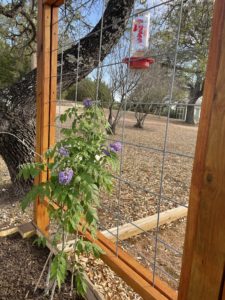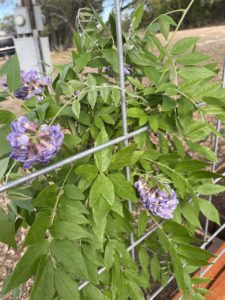Not All Wisterias Are the Same

Wisteria frutescens will help make this cattle panel trellis a colorful privacy screen.
Last month we decided to build a privacy screen to block our bedroom patio area. We settled on an open design with stock panel trellises and added planter boxes below. I was giddy at the prospect of another garden spot, imagining all sorts of vining vegetables climbing up the trellis. Nearly 12 feet of extra space for beans or peas!
My husband had other ideas. “It’s permanent, I’d like something we can plant once, then it’ll grow for years.” He suggested wisteria and I cringed. I’d known more than one person with wisteria that had grown into a monster vine, overtaking the trellis then moving on to the house, damaging siding and shingles. But in the interest of marital harmony, I decided to do some research.
A Native Texas Wisteria to the Rescue
Turns out there are multiple kinds of wisteria, and this is where using scientific names can come in handy. Wisteria frutescens, also known as Texas wisteria, is native to east Texas and the southeastern United States. The native Wisteria frutescens has a slower growth rate than its Asian counterpart, Wisteria sinensis, an import considered an invasive species by some.
Wisteria sinensis grows lightning fast: up to 10 feet a year and can choke out other trees as its hard, woody vines wrap tightly around a host tree and cause death by girdling. This rapid growth made it a darling of those in a hurry to have lots of coverage in a short time and I’m confident this is the type my friends with the roof problems must’ve had.
Wisteria frutescens can still reach heights of 30 feet, just not as quickly. It also has other advantages when it comes to flowers. Wisteria frutescens can flower in its first year and bloom throughout the summer. The plants we found at our local nursery already had flower buds which opened up shortly after planting. Wisteria sinensis can take 10 years or more to flower.
How to Tell the Difference

If you’re buying plants, look for the scientific name on the tag: Wisteria frutescens is the native species. This was the only choice offered at my favorite local nursery, but box stores definitely carry Wisteria sinensis. If the scientific name isn’t listed look for key phrases like: “growing up to 10 ft. or more annually.”
If you’re wondering about a vine already growing in your yard, if it’s taken over, there’s a good chance it’s Wisteria sinensis. Here are a few ways to tell the species apart:
- With Wisteria frutescens, leaves emerge first, then it flowers. Asian species bloom first, then leaf out.
- Also, Wisteria frutescens bloom clusters (racemes) are round and compact – like a pine cone, 3-6 inches in length, while the Asian species are twice that size.
- Once the blooms go to seed, Wisteria frutescens has smooth seed pods opposed to fuzzy pods with the Asian species.
It may take a few years for our Wisteria frutescens to cover the privacy screen, but that’s okay – I snuck in some bean seeds to grow alongside them this summer.
Additional Resources
Texas Invasive Species Institute
Wisteria frutescens information in the Wildflower.org Native Plant Database
Grow Green Native & Adapted Landscape Plants Searchable Database
About Gayleen Rabakukk
 Gayleen gardens in the hills of northwest Travis County. When she’s not digging in the dirt, she’s either writing or tending to her Bed & Breakfast, Hill Country Highland. Gayleen is a Travis County Master Gardener intern.
Gayleen gardens in the hills of northwest Travis County. When she’s not digging in the dirt, she’s either writing or tending to her Bed & Breakfast, Hill Country Highland. Gayleen is a Travis County Master Gardener intern.
